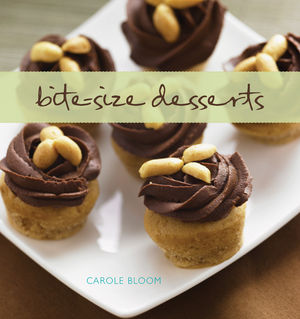 If you or any of your loved ones has a sweet tooth, you must know about my long time dear friend and baking expert, Carole Bloom. Carole is a European-trained pastry chef, confectioner, chocolatier, and best selling author of nine cookbooks.
If you or any of your loved ones has a sweet tooth, you must know about my long time dear friend and baking expert, Carole Bloom. Carole is a European-trained pastry chef, confectioner, chocolatier, and best selling author of nine cookbooks.
Her latest cookbook, just released from Wiley in April 2009, is Bite-Size Desserts. Carole is riding the wave of one of the hottest food trends in this country today, small desserts that deliver big delectable flavors. Bite-Size Desserts, has a lively and lovely format, beautiful mouth-watering photos, and a total of 87 tantalizing recipes.
I had her book one week, and had already gleefully made "cornmeal-dried cherry scones", "wicked brownie bites", and "raspberry-blueberry crisps". Below is a special treat for all of you, Carole Bloom's "Cornmeal-Dried Cherry Scones" recipe. Enjoy. For book and purchase information, click on, Bite-Size Desserts: Creating Mini Sweet Treats, from Cupcakes and Cobblers to Custards and Cookies
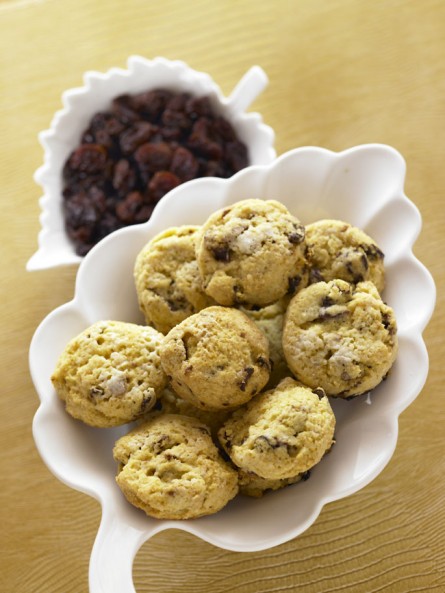
"I love to use cornmeal in baking because it provides lots of texture. It works deliciously with the dried tart cherries in these scones. These are lovely for breakfast, afternoon tea, and as a snack. They taste best when warm and can be reheated in a 350 degree oven for 7-9 minutes."
MAKES 2 dozen 2-inch round scones.
Ingredients: 3/4 cup (3-1/4 ounces) all purpose flour 2/3 cup (4 ounces) fine yellow cornmeal 1 tablespoon (1/4 ounce) plus 1 teaspoon granulated sugar 1-1/2 teaspoons baking powder 1/8 teaspoon kosher or fine-grained sea salt 2 ounces (4 tablespoons, 1/2 stick) unsalted butter, chilled 2/3 cup (3-1/2 ounces) dried tart cherries 1/3 cup plus 2 teaspoons heavy whipping cream 1 extra-large egg, at room temperature 1/2 teaspoon pure vanilla extract
Adjust the oven racks to the upper and lower thirds and preheat the oven to 350 degrees F. Line 2 baking sheets with parchment paper or nonstick liners.
*** Pulse together the flour, cornmeal, 1 tablespoon of sugar, baking powder, and salt in the work bowl of a food processor fitted with a steel blade.
*** Cut the butter into small pieces and add it to the four mixture. Pulse until the butter is cut into very tiny pieces, about 30 seconds. The texture should be sandy with very tiny lumps throughout. Add the dried cherries and pulse a few times to mix.
*** Use a fork to lightly beat 1/3 cup of cream with the egg and vanilla in a liquid measuring cup. With the food processor running, pour this mixture through the feed tube and process until the dough forms itself into a ball, about 30 seconds.
*** Dust a large piece of waxed or parchment paper with flour and turn the dough out onto it. Knead the dough briefly and form it into a round about 3/4 inch thick. Dip a 1-1/2 inch round plain-edge biscuit cutter in flour and use it to cut straight down through the dough and lift straight up, without twisting, to form the scones. Twisting seals the edges of the dough and keeps the the scones from rising well as they bake. Gather the scraps together, knead briefly, and roll and cut the remaining dough into scones. Transfer the scones to the lined baking sheets, leaving at least 1 inch of space between them so they have room to expand as they bake.
*** GARNISH
Brush the tops of the scones with the remaining 2 teaspoons of cream, taking care that it doesn't run down the sides and under the scones. If it does, wipe it up because it can cause the bottoms of the scones to burn. Lightly sprinkle the tops of the scones with the remaining 1 teaspoon sugar.
*** Bake for 9 minutes. Switch the baking sheets and bake another 9 minutes until the scones are light golden. Remove the baking sheets from the oven and cool the scones completely on the baking sheets on racks.
*** KEEPING Store the scones in an airtight plastic container between layers of waxed paper at room temperature up to 4 days. To freeze up to 4 months, wrap the container tightly in several layers of plastic wrap and aluminum foil. Use a large piece of masking tape and an indelible marker to label and date the contents. If frozen, defrost the scones overnight in the refrigerator and bring to room temperature before serving.
MAKING A CHANGE Add 1/3 cup of coarsely chopped toasted walnuts or pecans with the cherries. Replace the dried tart cherries with dried cranberries or dried blueberries.
Congratulations Carole, on your new Bite-Size Desserts cookbook! It is such a delightful cookbook to read, as well as bake with. Your flavor combinations are genius. Please visit www.carolebloom.com for more information on her cookbooks, classes, and schedule.


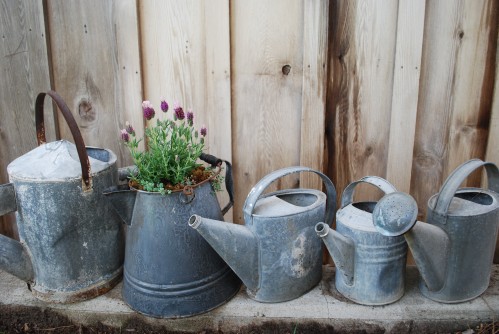 Have you ever walked into some one's home or garden for the first time, and immediately felt at ease, comfortable, with your senses confirming that this room or space is working in unison? Most likely your host or hostess has beautifully incorporated the basic design principles on purpose or unknowingly by instinct. Generally speaking, the best designed and pleasing spaces, rooms, and gardens, are the ones that have evolved over time, adding a little bit at a time. Remember to adhere to the five basic principles of design as you create your space. They are scale and proportion, balance, rhythm, emphasis, and harmony.
Have you ever walked into some one's home or garden for the first time, and immediately felt at ease, comfortable, with your senses confirming that this room or space is working in unison? Most likely your host or hostess has beautifully incorporated the basic design principles on purpose or unknowingly by instinct. Generally speaking, the best designed and pleasing spaces, rooms, and gardens, are the ones that have evolved over time, adding a little bit at a time. Remember to adhere to the five basic principles of design as you create your space. They are scale and proportion, balance, rhythm, emphasis, and harmony. There is nothing boring about Borage, Borago officinalis. It is the epitome of why herbs are so great, and how you can enjoy them in your garden as well as their many versatile uses.
There is nothing boring about Borage, Borago officinalis. It is the epitome of why herbs are so great, and how you can enjoy them in your garden as well as their many versatile uses.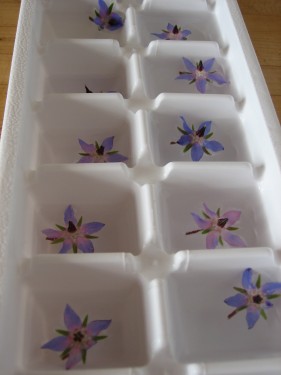
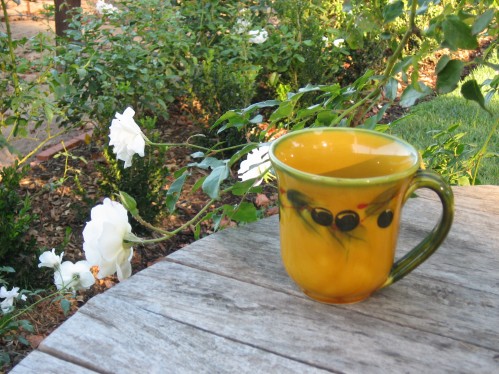 Each morning I start my day in our gardens and opening up our chicken coop for the day. It's early morning, and I am scurrying around to see if any new seeds have sprouted in our kitchen garden, what needs water, what is about to bloom, how my new roses are doing, if what I transplanted recently is doing well, and what chore or project needs to be done. It is also a time I reflect on my gratitude, my blessings, and my bliss. I call these "coffee cup thoughts".
Each morning I start my day in our gardens and opening up our chicken coop for the day. It's early morning, and I am scurrying around to see if any new seeds have sprouted in our kitchen garden, what needs water, what is about to bloom, how my new roses are doing, if what I transplanted recently is doing well, and what chore or project needs to be done. It is also a time I reflect on my gratitude, my blessings, and my bliss. I call these "coffee cup thoughts". Does your mom live a "stone's throw" away from you? Are you able to make her and all of your loved ones a delightful Mother's Day Brunch celebrating "her day" with your fresh eggs, delicately poached over heart-shaped polenta, melon-drizzled vinaigrette over arugula greens, blue cheese, and proscuitto, and gloriously ending with fresh berries and sour cream coffeecake? No, does she live out-of-state like my mom? Well, here is a great suggestion.
Does your mom live a "stone's throw" away from you? Are you able to make her and all of your loved ones a delightful Mother's Day Brunch celebrating "her day" with your fresh eggs, delicately poached over heart-shaped polenta, melon-drizzled vinaigrette over arugula greens, blue cheese, and proscuitto, and gloriously ending with fresh berries and sour cream coffeecake? No, does she live out-of-state like my mom? Well, here is a great suggestion.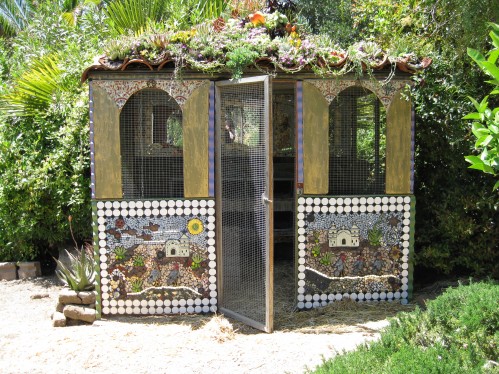
 This is another spring blooming delight, Orchid Rockrose, Cistus x purpureus. Although this is a native Mediterranean drought tolerant shrub, something about it reminds me of an English country garden.
This is another spring blooming delight, Orchid Rockrose, Cistus x purpureus. Although this is a native Mediterranean drought tolerant shrub, something about it reminds me of an English country garden. 